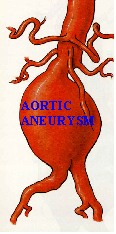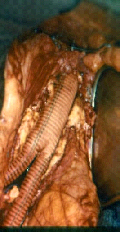Aortic Aneurysm

What is an aneurysm?
Aneurysms are dilations of blood vessels. Like water balloons with too much water, aneurysms can rupture if they get too large. Rupture is usually associated with death. Therefore, aneurysms should be repaired before rupture. Aneurysms can be found anywhere in the body. Typically, they are most commonly found in the belly or chest. Vascular surgeons are specially trained and board certified to treat patients with aneurysms.
The silent killer
Most patients don’t even know they have an aneurysm. Typically, most aneurysms are found by accident on a routine physical examination or during a CAT scan as part of the evaluation for other problems. During the study an incidental aneurysm is often identified.
Who should be checked and how patients are evaluated
Aneurysms tend to run in families. Therefore, if your parents or siblings have had an aneurysm, you should be checked. In addition, patients with long standing high blood pressure, coronary artery disease on high cholesterol should be examined for a possible aneurysm. The finding of a pulsating mass in the belly during a physical examination should prompt your physician to order an ultrasound on CAT scan. The CAT scan will give detailed information on the type, size, and location of the aneurysm (Figure 2). This information is vital for your vascular doctor. Based on the information obtained from the CAT scan, they can provide you with treatment recommendations.
Treatment Options
Not all aneurysms need to be repaired. We now know that when aneurysms in the belly and chest reach a certain size, the risk of rupture increases. In other words small aneurysms tend not to rupture, while large ones do. Therefore, depending on the size, your vascular doctor may choose to get yearly CAT scans to monitor the growth of your aneurysm or recommend repair.
 Aneurysms are treated by connecting bypass grafts to various arteries in your belly and sometimes legs. The traditional way is to make an incision in the belly and hand-sew the bypass graft onto the artery. Thanks to advances in technology, many aneurysms can now be fixed from the inside using endovascular techniques. Catheters are inserted into an artery and the bypass graft is deployed from within the artery. This eliminates the need for large incisions and patients often go home the next day. There are specific risks and benefits for each type of repair and as technology gets more sophisticated, these treatment techniques have better results in larger centers. Often, the latest improved versions of grafts are also released first in selected large centers. For more information consult a vascular surgeon at our center for detailed information.
Aneurysms are treated by connecting bypass grafts to various arteries in your belly and sometimes legs. The traditional way is to make an incision in the belly and hand-sew the bypass graft onto the artery. Thanks to advances in technology, many aneurysms can now be fixed from the inside using endovascular techniques. Catheters are inserted into an artery and the bypass graft is deployed from within the artery. This eliminates the need for large incisions and patients often go home the next day. There are specific risks and benefits for each type of repair and as technology gets more sophisticated, these treatment techniques have better results in larger centers. Often, the latest improved versions of grafts are also released first in selected large centers. For more information consult a vascular surgeon at our center for detailed information.

